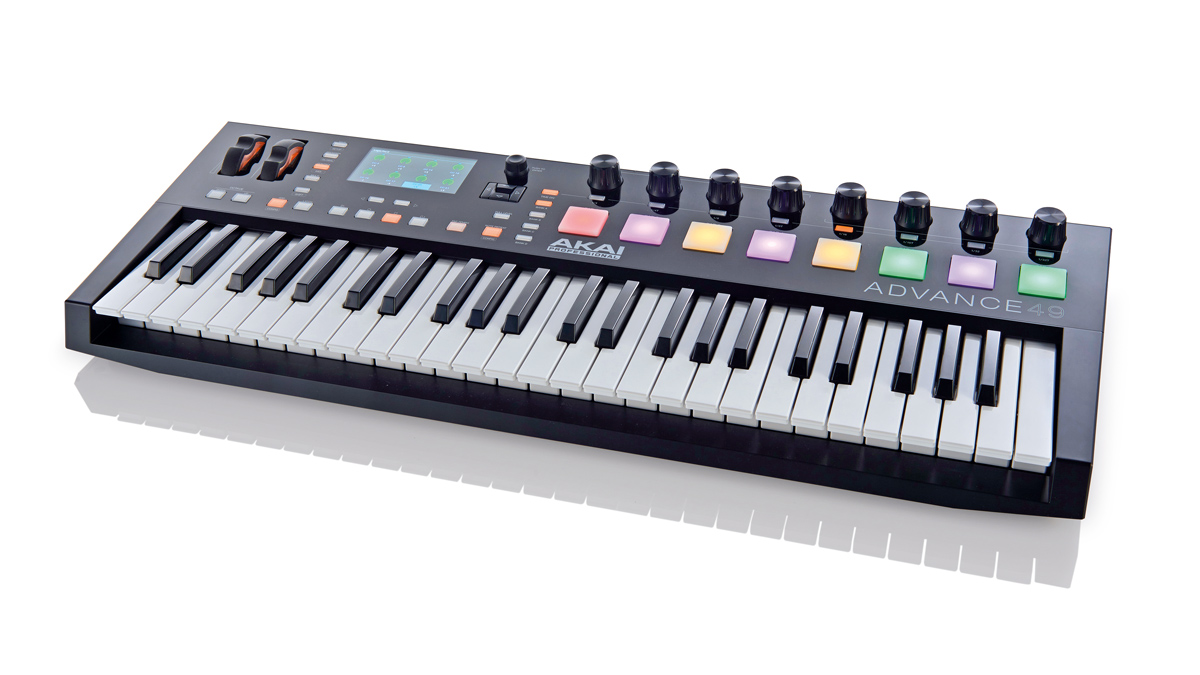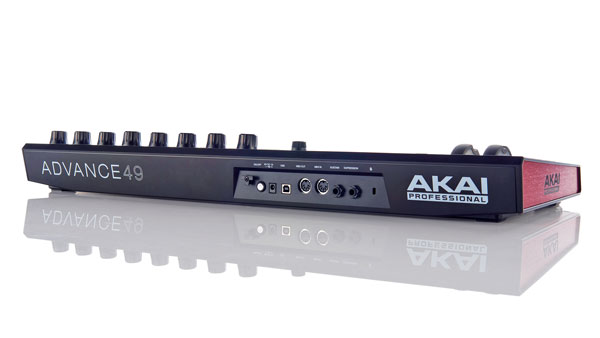MusicRadar Verdict
The Advance controllers elegantly remove the disconnect between your controller and DAW.
Pros
- +
Well built, looks great and easy to use. Colour screen makes editing a much more engaging experience. Plug-in mapping puts all your favourite VST plug-ins under direct control from the keyboard/controls.
Cons
- -
Keybed is way too stiff.
MusicRadar's got your back

Akai Advance 49

Rear
Akai's latest range of controllers, the Advance Series, falls into a new category of the keyboard controller market, largely created by the launch of Native Instrument's Komplete Kontrol S-series.
However, there is one key difference. Whereas the Kontrol-S is currently for Native Instrument plug-ins only, the Advance Series allows both Komplete plug-ins and also any of your other VST instruments to be directly mapped to the Advance's front panel controls.
(Update: while finishing this review, NI announced that in summer 2015 its Kontrol-S range will also be able to map to third party VST plug-ins, so the Kontrol-S and Advance Series will be direct competitors!)
There are three models in the new Advance range and each has a synth-action aftertouch-enabled keybed with either 25, 49 or 61 notes (fingers crossed for 73 or 88-note weighted models).
"It closes the gap between your DAW and your controller keyboard in an elegant and intuitive way"
For this review we're looking at the 49-key model. First impressions are great - the unit looks sleek (very current Roland we might add!), has a good weight to it and it's generally well constructed.
The controls feel tight/good quality (especially the eight chunky performance dials at the top right of the panel) and the rubberised pitch and mod wheels fit comfortably under the fingers and are backlit amber, which is both practical and looks great on stage.
The translucent mode buttons also glow a reassuring amber (and feel built to last) while there are eight MPC-type backlit pads laid out horizontally which glow several different colours to denote the current bank/operating mode.
These pads are large and very sensitive, enabling you to bring out the tiniest nuances in sounds and they also transmit channel aftertouch too.
There are a couple of downsides worth noting though. Firstly, the Advance misses a main overall MIDI/ master volume dial (though knob 1 is often auto-mapped to this function in the VIP software). But the major turn-off is the overly-stiff keybed. It takes far too much effort to get the keys to go down and playing lightly on the Advance will result in no notes being triggered at all.
We hope Akai will swap this keybed out for a more playable one - it's the only thing holding back the Advance hardware.
Making connections
Round the back, there's a USB socket which supplies buss power (and which also sends MIDI info to/from your DAW) plus standard MIDI In/Out connectors for connecting the Advance to other MIDI hardware - these ports can run simultaneously or separately to the USB MIDI/DAW connection which is nicely flexible.
There are also connections for sustain and expression pedals and a separate wall-wart power input (supply not supplied!) if you want to run the Advance purely as a standalone MIDI controller without a computer.
The screen is great - full colour, high resolution and everything is clear and easy to navigate with the cursors and combined jog wheel/enter button. Even when there's lots of stuff going on within the browser, everything still looks classy and is easy to follow.
Under the pitch and mod wheels are standard octave up/down controls and next to these are buttons for switching on and latching the built-in MIDI/DAW-syncable arpeggiator which has 107 built-in grooves/patterns with variable swing and time divisions (including 1/4, 1/8, 1/16 and 1/32, all with triplet versions). Above these are the four main mode buttons which take you to the key areas of the Advance 49's OS.
In the mode
Main takes you to the main window for DAW template selection (templates for controlling Logic, Cubase, Bitwig, Ableton, FL studio and Reaper are included, though there is still some custom setting up needed).
You'll also find chromatic pad/major/minor scale templates here, 21 user slots for storing your own controller set-up templates, plus MIDI channel selection options (A 1-16 and B-16).
When hooked up to your DAW, Main also takes you to the VIP software main window displaying the plug-in selected with its available patches on the right of the screen.
"For live gigs, the clever DAW integration and less reliance on the computer screen is a god send!"
The Browser button takes you to the main sound selection area within the VIP software and VIP's 'auto-map' function effortlessly scans your VST plug-in folder(s) and directly imports your plug-in presets into the browser.
VIP works standalone or as a DAW hosted plug-in and it offers a fully integrated and user-customisable tagged browsing system where you can quickly search sounds by instrument, style, plug-in (and more) and we found it easy to navigate.
Sound selection/ navigation is also easy using the cursor buttons/jog wheel and whatever you select on the Advance'sBrowser screen is also reflected on your DAW and vice versa, (much like using an MPC Renaissance). VIP really does make it feel like your VST plug-ins are actually hosted in the Advance unit itself.
Browser mode also has a 'shift' function which takes you to the Global area. Here you can set the main MIDI channel, screen brightness and the transport format so that you can control play/record/stop and cycle on your DAW (MIDI, CC, MMC, MMC/MIDI and PTEX/ Pro Tools Express modes are available).
It was a doddle to set up the Advance hardware with Logic X's transport - simply switch MMC on in Logic and on the Advance.
Control mode has three screens. The first deals with CC assignments for the eight main Advance dials, the second screen deals with CC assignments for the eight buttons under the main dials and the third screen deals with CC assignments for the MPC pads over four banks (ABCD).
While there are lots of assignable controls available, it's thankfully all very easy to customise too. Simply select the controller (dial/pad/ button) on screen with the cursor and use the jog wheel to enter the desired CC number and press to confirm.
Notably, when the Advance hardware is connected to your DAW via USB and to external hardware via the MIDI ports at the same time, Control mode shows the VIP auto-mapped dials and external MIDI CC mapped dials on screen simultaneously which is great (the two 'page' buttons under the screen allow you to scroll through several pages of mapped controls swiftly).
Finally, the Multi button deals with multi-timbral set-ups within VIP. You can set up splits and layers (eight different plug-ins can be triggered at once) plus trigger sounds from user-defined keyboard zones too. It's all surprisingly powerful!
All things considered, we really dig the Advance concept. It closes the gap between your DAW and your controller keyboard in an elegant and generally intuitive way and we can see these being very popular indeed.
While the initial installation/set-up takes a while, VIP works reliably and the included content is excellent too. Our only reservation is the overly-stiff keybed (this really needs revising), plus currently there are no weighted models on offer for piano-centric players.
In all other respects Akai has brought something hugely useful to the market and the Advance hardware plus VIP software puts the emphasis back on hands-on creating/performing rather than screen-led mouse-centric programming - this is a great thing for both studio heads and live performers alike!
“I called out to Mutt and said, ‘How about this?’... It was a complete fluke": How Def Leppard created a rock anthem - with a little bit of divine intervention
Baby Audio's Smooth Operator spectral balancing plugin goes pro
"It was ugly, like watching a divorce between four people. After a while, I had to get out": Beatles engineer Geoff Emerick on the recording of Abbey Road, track-by-track









